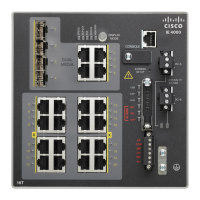22
Switch Installation
Connecting to Power
Connecting the AC Power Source to the Power Converter
Caution: AC power sources must be dedicated AC branch circuits. Each branch circuit must be protected by a
dedicated two-pole circuit breaker.
Caution: Do not turn on AC power until the wiring is secured.
1. Remove the plastic cover from the input power terminals and set it aside.
2. Insert the exposed ground wire lead (10-to-12 AWG cable) into the power converter ground wire connection. Ensure
that only wire with insulation extends from the connector. Note that the position of the power converter may vary on
different switch models.
3. Tighten the ground wire terminal block screw.
Note: Torque to 10 in-lb (1.13Nm).
4. Insert the line and neutral wire leads into the terminal block line and neutral connections. Make sure that you cannot
see any wire lead. Ensure that only wire with insulation extends from the connectors.
5. Tighten the line and neutral terminal block screws.
Note: Torque to 10 in-lb (1.13Nm).
6. Replace the plastic cover over the terminal block.
7. Connect the other end of the wiring to your AC power source.
Connecting the Power Converter to a DC Power Source
You can also connect the power converter to a DC power source. Several power supplies can be used. Refer to Table 2
on page 19 for the appropriate DC input ratings.
Note: Use copper conductors only, rated at a minimum temperature of 167°F (75°C).
1. Measure a single length of stranded copper wire long enough to connect the power converter to the earth ground.
The wire color might differ depending on the country that you are using it in.
For connections from the power converter to earth ground, use shielded 14-AWG stranded copper wire.
2. Measure a length of twisted-pair copper wire long enough to connect the power converter to the DC power source.
For DC connections from the power converter to the DC source, use 10-AWG twisted-pair copper wire.
3. Using a 18-gauge wire-stripping tool, strip the ground wire and both ends of the twisted pair wires to 0.25 inch (6.3
mm) ± 0.02 inch (0.5 mm). Do not strip more than 0.27 inch (6.8 mm) of insulation from the wires. Stripping more
than the recommended amount of wire can leave exposed wire from the power and relay connector after installation.
4. Connect one end of the stranded copper wire to a grounded bare metal surface, such as a ground bus, a grounded
DIN rail, or a grounded bare rack.
5. Insert the other end of the exposed ground wire lead into the earth-ground wire connection on the power converter
terminal block. Note that the position of the power converter may vary on different switch models.
6. Tighten the earth-ground wire connection terminal block screw.
Note: Torque to 8 in.-lb, not to exceed 10 in-lb.

